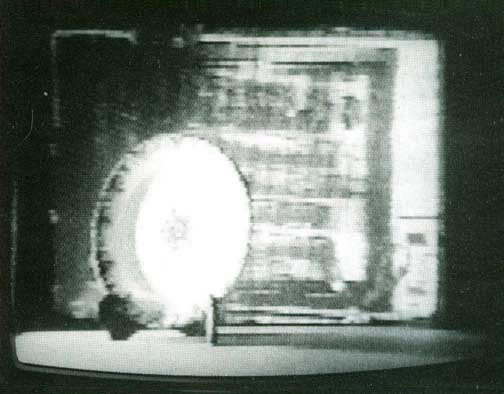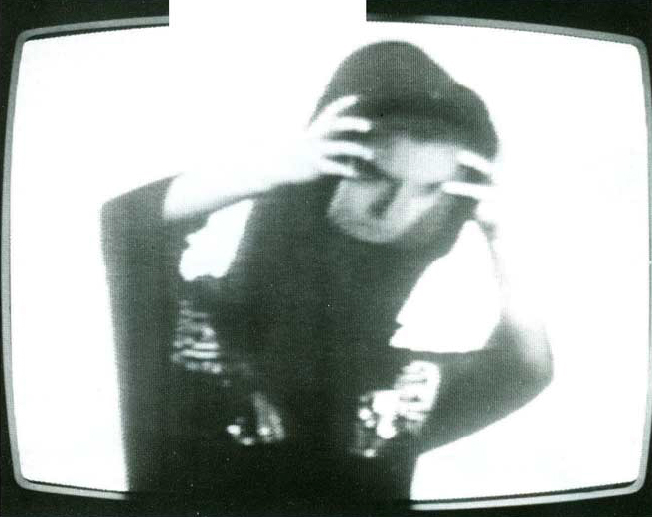
Fig. 2: Carlos Fadon Vicente, Still Life/Alive, SSTV frame sent from Pittsburgh to Sao Paulo.
(Photo: Paulo Laurentiz)
A final improvisational period was also foreseen. We thought that an extended concluding
time would permit a spontaneous flow of ideas and emotions resulting from the immediate
experience of the event.
THE EVENT IN SAO PAULO
The Teleconferences
On Monday, 25January 1988, the city of
Sao Paulo was celebrating its 434th anniversary
under a thunderstorm. Nevertheless,
that night an attentive audience
was waiting for the transmissions from
Pittsburgh after having crossed the
flooded streets of the city.
A few minutes after the Sao Paulo/
Pittsburgh connection was established
(Fig. 1), Breland's speech from Pittsburgh,
"Floating in a Telematic Culture",
was received in the auditorium at
the Museum of Image and Sound in Sao
Paulo. The audience could feel his enthusiasm
in communicating with the
city and its inhabitants [4]. We could
also see his face, for the first time, in the
slow-scanned video images.
Composite images resulting from the
electronic mixing of Sao Paulo and
Pittsburgh landscapes and transmitted
by Jim Kocher, DAX operational director
for the event, alternated on the
screen with frames of Breland's face.
The synthesized city was a metaphor for
the telematic culture as defined by Breland:
"By combining the two cities in
slow scan technology we appear in electronic
space as an extension of each
other where we become one" [5].
Breland identified possibilities for an
ecological renaissance in the human
conquest of outer space and in the
recently extended telematic culture.
From his perspective, artists have a creative
role to play in the encompassing telematic culture: "If the Earth is a living organism, are we a part of the process?" he asked.
His own answer could be detected in the final words of his lecture:
I want to extend and amplify the possibilities of life. I want to discover
the power of my
imagination. [ want to exercise my fullest potential as
a thinking human being. It is
possible to do, but will we do it? Can we
do it? Do we have a choice? [6].
Breland reaffirmed his faith in the artist's power to renew the life forces essential for
planetary survival.
Coincidentally, the two talks sent from Sao Paulo dealt with similar questions and
demonstrated the same enthusiastic belief in the healing effects of widespread
telecommunications upon the earth's surface [7].
'The Time of the Planet", Laurentiz's speech, advanced a semiotic view of contemporary
cultural change under the impact of electronic technology. Defining reality as "the
reference of the real according to certain sensors", Laurentiz invited us to consider
that the newly disseminated electronic sensors were redefining reality itself [8].
The process of change, according to the Brazilian lecturer, has affected regionally
defined values: "Electronic sensors display the species to universal knowledge ... These
sensors make regional cultures shock, hybridizing them
... [they] despise idiosyncratic value highlighting the commonly known universal cultural
profile" [9].
Laurentiz believes that wide-range simultaneous communication and human expansion
into outer space have been eliciting new planetary values. Therefore
regionalized time, epitomized by the Greenwich Meridian, no longer has meaning.
"Electronic sensors synchronize space, reinterpreting time", he asserted [10], also
suggesting that electronic sensors could connect human consciousness all over the
planet's surface.
In "Cyclotopia", my own lecture, the planet was also portrayed as a living being: "The
planetary organism sensitizes itself through the impulses of an electronervous system. While we are in contact, we make it and we perceive it - the pulsing of the planet" [11].
The lecture emphasized the transformation of language under the impact of communication technology. It stressed
the importance of language as a tool for
thought, pointing out the need for linguistic
rupture so that new configurations,
and consequently new concepts,
might arise.

Fig. 3: The Videocreature, performed by Otavio Donasci, experiences a face just received from Pittsburgh during the show. (Photo: Paulo Laurentiz)
|

